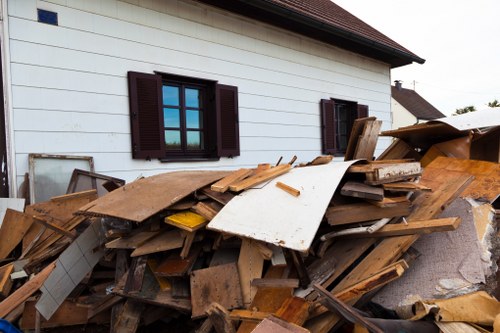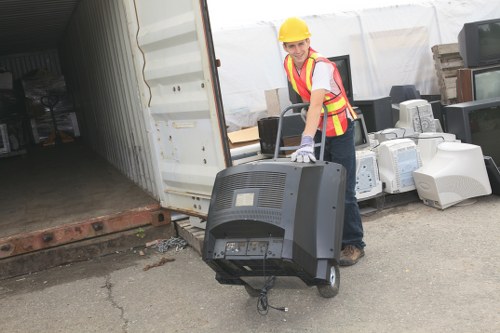Furniture Clearance in Flat Clearance
Understanding Furniture Clearance

Furniture clearance is an essential component of flat clearance, ensuring that unwanted or surplus items are efficiently removed from a residence. Whether you're moving to a new location, downsizing, or simply decluttering, effective furniture clearance can significantly streamline the process.
Flat clearance involves not only the physical removal of furniture but also the responsible disposal, donation, or recycling of items. This comprehensive approach ensures that the space is left tidy and ready for the next occupant, while also promoting environmental sustainability.
Managing furniture clearance can be challenging without proper planning and resources. From handling large, bulky items to ensuring that disposed items are processed correctly, having a structured strategy is crucial for a successful clearance.
Importance of Furniture Clearance in Flat Clearance

Effective furniture clearance plays a pivotal role in the overall flat clearance process. It helps in optimizing the available space, making the flat appear more spacious and inviting. Additionally, it prevents potential damage or wear to the property that can occur from cluttered or improperly stored furniture.
Moreover, responsible furniture clearance contributes to environmental conservation by ensuring that items are recycled or donated rather than ending up in landfills. This not only reduces waste but also supports community initiatives by providing useful items to those in need.
Financial considerations also make furniture clearance important. Properly managed clearance can prevent unnecessary costs associated with storage fees, fines for property damages, or disposal charges that might arise from improper handling of items.
Steps to Efficient Furniture Clearance

Achieving efficient furniture clearance requires a systematic approach. Here are the key steps to follow:
1. Assessment and Inventory
Begin by assessing all the furniture items in your flat. Create an inventory list, categorizing items based on their condition and deciding whether they will be kept, donated, sold, or disposed of.
2. Sorting and Classification
Sort the furniture into different categories. This makes the clearance process more organized and ensures that each item is handled appropriately.
3. Planning the Clearance
Develop a clearance plan outlining the timeline, resources needed, and responsibilities. This helps in executing the clearance efficiently without last-minute hassles.
4. Execution and Removal
Proceed with the removal of furniture based on your plan. Ensure that items are transported safely to their next destination, whether it’s a donation center, recycling facility, or disposal site.
5. Final Inspection
Conduct a final inspection of the flat to ensure that all unwanted furniture has been cleared and the space is ready for the next steps, such as cleaning or new furniture installation.
Choosing the Right Furniture Clearance Service

Selecting the appropriate furniture clearance service is crucial for a smooth flat clearance. Here are factors to consider:
- Reputation: Opt for services with positive reviews and a proven track record.
- Experience: Experienced professionals are better equipped to handle all types of furniture clearance efficiently.
- Services Offered: Ensure the service provides comprehensive clearance, including removal, donation, and recycling options.
- Pricing: Compare prices from different providers to ensure you’re getting value for money.
- Licensing and Insurance: Verify that the service is licensed and insured to protect against potential damages or losses.
By considering these factors, you can choose a furniture clearance service that meets your specific needs and ensures a hassle-free experience.
Book your service now with a trusted provider to ensure efficient and responsible clearance.
Benefits of Professional Furniture Clearance

Engaging professional furniture clearance services offers numerous advantages:
- Time-Saving: Professionals can complete the clearance process more swiftly than doing it yourself.
- Efficiency: Experienced teams can handle large volumes of furniture systematically, ensuring nothing is overlooked.
- Safety: Proper handling of heavy or bulky items reduces the risk of injury or property damage.
- Environmental Responsibility: Professional services often include recycling and donation options, promoting sustainability.
- Cost-Effective: While there’s an upfront cost, professional clearance can save money in the long run by avoiding fines and reducing the need for multiple disposal trips.
These benefits make professional furniture clearance a worthwhile investment for anyone undertaking flat clearance.
Don’t hesitate to contact us today to take advantage of these benefits and ensure a smooth clearance process.
Cost Factors in Furniture Clearance

Understanding the cost factors involved in furniture clearance can help you plan and budget effectively. Here are key considerations:
- Volume of Furniture: The number of items to be cleared directly impacts the cost. More items require more resources and time.
- Type of Furniture: Larger or heavier items like sofas, wardrobes, and dining sets may cost more to clear due to the additional effort required.
- Accessibility: If your flat has limited access, such as narrow hallways or stairs, clearance services might charge extra for the additional labor.
- Distance: The distance to the disposal or donation center can affect transportation costs.
- Additional Services: Services like disassembly, packing, or cleaning may incur extra charges.
To manage costs effectively, obtain detailed quotes from multiple providers and understand what each quote includes. Transparent pricing ensures there are no hidden costs during the clearance process.
Consider bundling services or negotiating for discounts, especially if you have a large volume of furniture to clear.
Environmental Considerations in Furniture Clearance

Furniture clearance should be approached with environmental responsibility in mind. Here’s how to make eco-friendly choices:
Recycling and Upcycling
Many furniture items can be recycled or upcycled, reducing waste and conserving resources. Recycling centers often accept materials like metal, wood, and plastics, which can be repurposed into new products.
Donation
Donating usable furniture to charities or non-profit organizations helps those in need while promoting sustainability. This is a win-win situation where you contribute to the community and reduce waste.
Responsible Disposal
For items that cannot be donated or recycled, ensure they are disposed of responsibly. Follow local regulations for waste disposal to minimize environmental impact.
By prioritizing eco-friendly practices in your furniture clearance, you contribute to environmental conservation and support community well-being.
DIY vs. Professional Furniture Clearance

When it comes to furniture clearance, you have two main options: doing it yourself (DIY) or hiring professional services. Each approach has its pros and cons.
DIY Furniture Clearance
Opting for a DIY approach can be cost-effective, allowing you to save on service fees. It also provides full control over the clearance process.
- Pros: Lower costs, flexible scheduling, personal oversight of the process.
- Cons: Time-consuming, physically demanding, potential for improper disposal.
Professional Furniture Clearance
Hiring professionals ensures that the clearance is handled efficiently and responsibly. Professionals bring expertise and resources that can make the process seamless.
- Pros: Saves time and effort, proper handling of items, responsible disposal and donation.
- Cons: Higher upfront costs, less personal control over the process.
Ultimately, the choice depends on your specific needs, budget, and the volume of furniture to be cleared. For large-scale or complex clearances, professional services are often the better option.
If you’re leaning towards convenience and efficiency, book your service now with a reputable furniture clearance provider.
Preparing for Furniture Clearance

Preparation is key to a successful furniture clearance. Here are steps to ensure you’re ready:
- Inventory Your Furniture: Make a detailed list of all items to be cleared. This helps in organizing and categorizing items for donation, sale, or disposal.
- Measure Your Space: Ensure that furniture can be moved out of your flat without issues. Measure doorways, hallways, and staircases to plan the removal process.
- Disassemble Large Furniture: If possible, disassemble large pieces to make transportation easier and prevent damage.
- Protect Your Property: Use protective covers for floors and walls to prevent scratches or damage during the clearance process.
- Clear Pathways: Ensure that pathways are free from obstacles to facilitate smooth movement of furniture.
By following these preparatory steps, you can enhance the efficiency and safety of your furniture clearance process.
Don’t wait until the last minute; start your preparations early to ensure a smooth and stress-free clearance experience.
Common Challenges in Furniture Clearance

Furniture clearance can present several challenges. Being aware of these potential issues and knowing how to address them can save you time and stress:
1. Large and Bulky Items
Handling large furniture pieces can be physically demanding and risky. To mitigate this, consider hiring professionals who have the necessary equipment and expertise.
2. Limited Timeframes
Often, clearance needs to be done within a tight schedule. Planning ahead and scheduling services in advance can help ensure timely clearance.
3. Access Constraints
Narrow hallways, steep stairs, or tight corners can complicate the removal process. Measuring and planning the optimal route can alleviate some of these constraints.
4. Emotional Attachment
Letting go of furniture can be emotionally challenging, especially items with sentimental value. Take your time to decide on the best course of action for each piece.
5. Disposal Regulations
Local disposal regulations may dictate how certain items should be handled. Researching and understanding these rules can prevent legal issues and ensure responsible disposal.
By anticipating these challenges, you can implement strategies to overcome them, making your furniture clearance process smoother and more efficient.
If you encounter any of these challenges, don’t hesitate to contact us today for expert assistance.
Environmental Impact of Furniture Clearance
Furniture clearance has significant environmental implications. Making eco-friendly choices during the clearance process can contribute to sustainability and reduce your carbon footprint.
Recycling
Recycling furniture materials like wood, metal, and plastics helps in conserving natural resources and reducing waste. Many components of furniture can be repurposed into new products, promoting a circular economy.
Upcycling
Upcycling involves transforming old furniture into something new and functional. This creative approach not only extends the life of items but also adds unique value to your space.
Donation
Donating usable furniture to charities or non-profit organizations supports those in need and minimizes environmental waste. It’s a socially responsible way to clear out space while benefiting the community.
By adopting these environmentally conscious practices, you contribute to a more sustainable future while effectively managing your furniture clearance.
Legal Considerations in Furniture Clearance
Understanding the legal aspects of furniture clearance is crucial to avoid potential issues. Here are some key points to consider:
1. Local Disposal Laws
Different regions have specific regulations regarding the disposal of household items. Ensure that your clearance process complies with these local laws to avoid fines or legal complications.
2. Hazardous Materials
Some furniture items may contain hazardous materials like lead paint or chemicals. Proper handling and disposal of these items are mandatory to protect health and the environment.
3. Tax Implications
If you plan to donate furniture, keep records of donations as they may be tax-deductible. Consult with a tax professional to understand the implications.
Being aware of these legal considerations ensures that your furniture clearance is conducted responsibly and within the bounds of the law.
For more guidance on legal aspects, consider consulting with professionals who specialize in furniture clearance and disposal.
Maximizing Efficiency in Furniture Clearance
Efficiency is key to a successful furniture clearance. Implement these strategies to streamline the process:
1. Prioritize Tasks
Identify which items need to be cleared first based on urgency or ease of removal. Prioritizing tasks helps in managing time effectively.
2. Delegate Responsibilities
If you're working with a team or family members, assign specific tasks to each person. Delegation reduces individual workload and speeds up the clearance process.
3. Use Proper Tools
Equip yourself with the necessary tools like dollies, straps, and protective gear to handle furniture safely and efficiently.
By focusing on these efficiency-boosting strategies, you can ensure that your furniture clearance is conducted swiftly and without unnecessary complications.
Ready to clear your space efficiently? Contact us today for expert assistance.
Post-Clearance Tips
After completing furniture clearance, there are several steps to ensure the space is ready for its next phase:
1. Deep Cleaning
Thoroughly clean the flat to remove any dust or debris left from the clearance process. This prepares the space for new furniture or for inspection by property managers.
2. Inspection
Inspect the flat to ensure that all areas have been cleared and there is no remaining clutter. Address any overlooked items promptly.
3. Planning for New Furniture
If you plan to move new furniture into the flat, use this opportunity to plan the layout and placement of each piece. Proper planning can enhance the functionality and aesthetics of your space.
These post-clearance steps help in maintaining the cleanliness and order of your flat, setting the stage for a smooth transition to the next phase.
Ensure all steps are completed by booking your service now with a professional clearance provider.
Conclusion
Furniture clearance is a fundamental aspect of flat clearance, contributing significantly to a seamless moving or decluttering experience. By understanding its importance, following structured steps, and considering professional assistance, you can manage the process efficiently and responsibly.
From assessing and planning to execution and post-clearance activities, each phase plays a crucial role in ensuring that your flat is cleared effectively and prepared for its next use. Embracing environmentally conscious practices and adhering to legal guidelines further enhances the positive impact of your clearance efforts.
Don’t let the challenges of furniture clearance overwhelm you. With the right strategies and support, you can achieve a smooth and efficient clearance process.
Book your service now and take the first step towards a clutter-free and organized living space.

